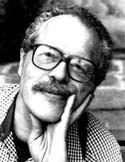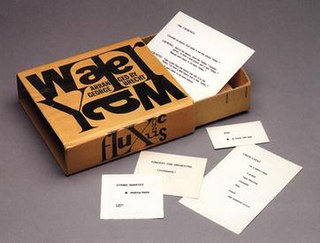
John Milton Cage Jr. was an American composer and music theorist. A pioneer of indeterminacy in music, electroacoustic music, and non-standard use of musical instruments, Cage was one of the leading figures of the post-war avant-garde. Critics have lauded him as one of the most influential composers of the 20th century. He was also instrumental in the development of modern dance, mostly through his association with choreographer Merce Cunningham, who was also Cage's romantic partner for most of their lives.

Fluxus was an international, interdisciplinary community of artists, composers, designers, and poets during the 1960s and 1970s who engaged in experimental art performances which emphasized the artistic process over the finished product. Fluxus is known for experimental contributions to different artistic media and disciplines and for generating new art forms. These art forms include intermedia, a term coined by Fluxus artist Dick Higgins; conceptual art, first developed by Henry Flynt, an artist contentiously associated with Fluxus; and video art, first pioneered by Nam June Paik and Wolf Vostell. Dutch gallerist and art critic Harry Ruhé describes Fluxus as "the most radical and experimental art movement of the sixties".
Noise music is a genre of music that is characterised by the expressive use of noise. This type of music tends to challenge the distinction that is made in conventional musical practices between musical and non-musical sound. Noise music includes a wide range of musical styles and sound-based creative practices that feature noise as a primary aspect.

La Monte Thornton Young is an American composer, musician, and performance artist recognized as one of the first American minimalist composers and a central figure in Fluxus and post-war avant-garde music. He is best known for his exploration of sustained tones, beginning with his 1958 composition Trio for Strings. His compositions have called into question the nature and definition of music, most prominently in the text scores of his Compositions 1960. While few of his recordings remain in print, his work has inspired prominent musicians across various genres, including avant-garde, rock, and ambient music.

Dick Higgins was an American artist, composer, art theorist, poet, publisher, printmaker, and a co-founder of the Fluxus international artistic movement. Inspired by John Cage, Higgins was an early pioneer of electronic correspondence. Higgins coined the word intermedia to describe his artistic activities, defining it in a 1965 essay by the same name, published in the first number of the Something Else Newsletter. His most notable audio contributions include Danger Music scores and the Intermedia concept to describe the ineffable inter-disciplinary activities that became prevalent in the 1960s.
Avant-garde music is music that is considered to be at the forefront of innovation in its field, with the term "avant-garde" implying a critique of existing aesthetic conventions, rejection of the status quo in favor of unique or original elements, and the idea of deliberately challenging or alienating audiences. Avant-garde music may be distinguished from experimental music by the way it adopts an extreme position within a certain tradition, whereas experimental music lies outside tradition.
Intermedia is an art theory term coined in the mid-1960s by Fluxus artist Dick Higgins to describe the strategies of interdisciplinarity that occur within artworks existing between artistic genres. It was also used by John Brockman to refer to works in expanded cinema that were associated with Jonas Mekas' Film-Makers’ Cinematheque. Gene Youngblood also described intermedia, beginning in his Intermedia column for the Los Angeles Free Press beginning in 1967 as a part of a global network of multiple media that was expanding consciousness. Youngblood gathered and expanded upon intermedia ideas from this series of columns in his 1970 book Expanded Cinema, with an introduction by Buckminster Fuller. Over the years, intermedia has been used almost interchangeably with multi-media and more recently with the categories of digital media, technoetics, electronic media and post-conceptualism.

James Tenney was an American composer and music theorist. He made significant early musical contributions to plunderphonics, sound synthesis, algorithmic composition, process music, spectral music, microtonal music, and tuning systems including extended just intonation. His theoretical writings variously concern musical form, texture, timbre, consonance and dissonance, and harmonic perception.

Henry Flynt is an American philosopher, musician, writer, activist, and artist connected to the 1960s New York avant-garde. He coined the term "concept art" in the early 1960s, during which time he was associated with figures in the Fluxus scene. He later received attention for his anti-art demonstrations against New York cultural institutions in 1963 and 1964.
Process music is music that arises from a process. It may make that process audible to the listener, or the process may be concealed.

4′33″ is a modernist composition by American experimental composer John Cage. It was composed in 1952 for any instrument or combination of instruments; the score instructs performers not to play their instruments throughout the three movements. It is divided into three movements, lasting 30 seconds, two minutes and 23 seconds, and one minute and 40 seconds, respectively, although Cage later stated that the movements' durations can be determined by the musician. As suggested by the title, the composition lasts four minutes and 33 seconds. It is marked by silence except for ambient sound, which is intended to contribute to the performance.

Downtown music is a subdivision of American music, closely related to experimental music, which developed in downtown Manhattan in the 1960s.
Minimal music is a form of art music or other compositional practice that employs limited or minimal musical materials. Prominent features of minimalist music include repetitive patterns or pulses, steady drones, consonant harmony, and reiteration of musical phrases or smaller units. It may include features such as phase shifting, resulting in what is termed phase music, or process techniques that follow strict rules, usually described as process music. The approach is marked by a non-narrative, non-teleological, and non-representational approach, and calls attention to the activity of listening by focusing on the internal processes of the music.

Alison Knowles is an American visual artist known for her installations, performances, soundworks, and publications. Knowles was a founding member of the Fluxus movement, an international network of artists who aspired to merge different artistic media and disciplines. Criteria that have come to distinguish her work as an artist are the arena of performance, the indeterminacy of her event scores resulting in the deauthorization of the work, and the element of tactile participation. She graduated from Pratt Institute in New York with an honors degree in fine art. In May 2015, she was awarded an honorary doctorate degree by Pratt.
Something Else Press was founded by Dick Higgins in 1963. It published many important Intermedia texts and artworks by such Fluxus artists as Higgins, Ray Johnson, Alison Knowles, Allan Kaprow, George Brecht, Daniel Spoerri, Robert Filliou, Al Hansen, John Cage, Emmett Williams and by such important modernist figures as Gertrude Stein, Henry Cowell, and Bern Porter.
Takehisa Kosugi was a Japanese composer, violinist and artist associated with the Fluxus movement.
Experimental music is a general label for any music or music genre that pushes existing boundaries and genre definitions. Experimental compositional practice is defined broadly by exploratory sensibilities radically opposed to, and questioning of, institutionalized compositional, performing, and aesthetic conventions in music. Elements of experimental music include indeterminacy, in which the composer introduces the elements of chance or unpredictability with regard to either the composition or its performance. Artists may approach a hybrid of disparate styles or incorporate unorthodox and unique elements.

Water Yam is an artist's book by the American artist George Brecht. Originally published in Germany, June 1963 in a box designed by George Maciunas and typeset by Tomas Schmit, it has been re-published in various countries several times since. It is now considered one of the most influential artworks released by Fluxus, the internationalist avant-garde art movement active predominantly in the 1960s and '70s. The box, sometimes referred to as a Fluxbox or Fluxkit, contains a large number of small printed cards, containing instructions known as event-scores, or fluxscores. Typically open-ended, these scores, whether performed in public, private or left to the imagination, leave a lot of space for chance and indeterminacy, forcing a large degree of interpretation upon the performers and audience.
In some cases [event-scores] would arise out of the creation of the object, while in others the object was discovered and Brecht subsequently wrote a score for it, thus highlighting the relationship between language and perception. Or, in the words of the artist, "ensuring that the details of everyday life, the random constellations of objects that surround us, stop going unnoticed." The event-score was as much a critique of conventional artistic representation as it was a gesture of firm resistance against individual alienation.
Source: Music of the Avant-Garde, also known as Source Magazine, was an independent, not-for-profit musical and artistic magazine published between 1967 and 1973 by teachers and students of the University of California, Davis, California. It emerged from the flourishing Californian musical experimentalism of the late 1950s-early 1960s, at UC-Davis and Mills College. The 11 issues document new music practices of the period like indeterminacy, performance, graphic scores, electronic music and intermedia arts.
Eric Andersen is a Danish artist associated with the Fluxus art movement. He lives in Copenhagen, Denmark.










